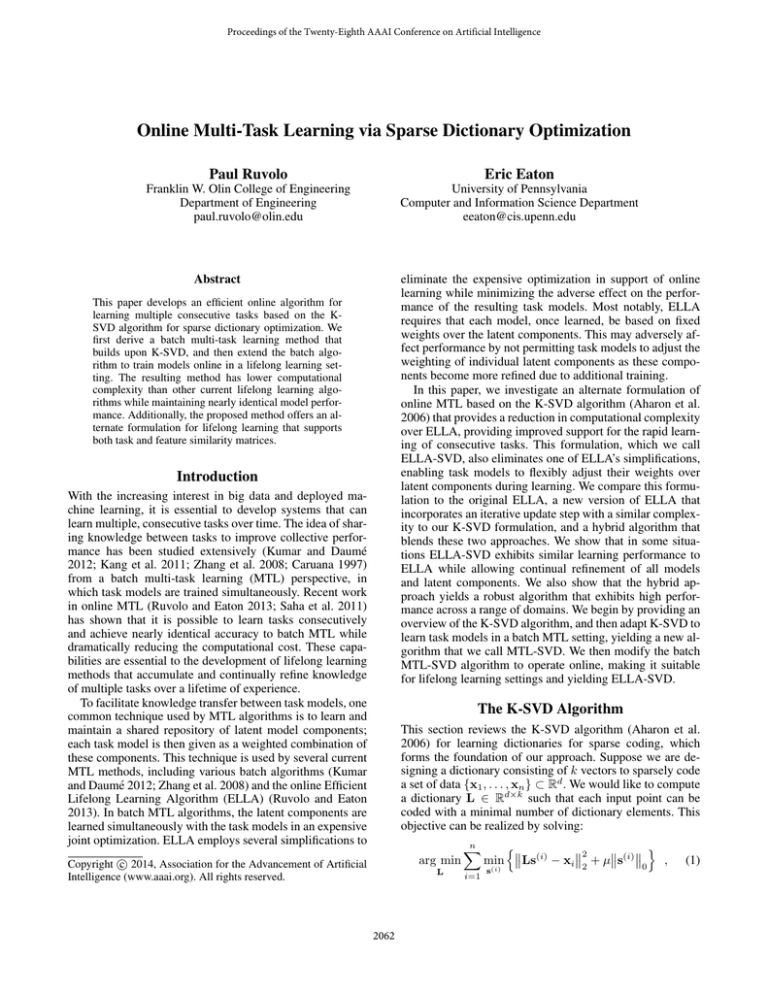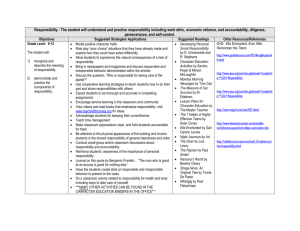
Proceedings of the Twenty-Eighth AAAI Conference on Artificial Intelligence
Online Multi-Task Learning via Sparse Dictionary Optimization
Paul Ruvolo
Eric Eaton
Franklin W. Olin College of Engineering
Department of Engineering
paul.ruvolo@olin.edu
University of Pennsylvania
Computer and Information Science Department
eeaton@cis.upenn.edu
Abstract
eliminate the expensive optimization in support of online
learning while minimizing the adverse effect on the performance of the resulting task models. Most notably, ELLA
requires that each model, once learned, be based on fixed
weights over the latent components. This may adversely affect performance by not permitting task models to adjust the
weighting of individual latent components as these components become more refined due to additional training.
In this paper, we investigate an alternate formulation of
online MTL based on the K-SVD algorithm (Aharon et al.
2006) that provides a reduction in computational complexity
over ELLA, providing improved support for the rapid learning of consecutive tasks. This formulation, which we call
ELLA-SVD, also eliminates one of ELLA’s simplifications,
enabling task models to flexibly adjust their weights over
latent components during learning. We compare this formulation to the original ELLA, a new version of ELLA that
incorporates an iterative update step with a similar complexity to our K-SVD formulation, and a hybrid algorithm that
blends these two approaches. We show that in some situations ELLA-SVD exhibits similar learning performance to
ELLA while allowing continual refinement of all models
and latent components. We also show that the hybrid approach yields a robust algorithm that exhibits high performance across a range of domains. We begin by providing an
overview of the K-SVD algorithm, and then adapt K-SVD to
learn task models in a batch MTL setting, yielding a new algorithm that we call MTL-SVD. We then modify the batch
MTL-SVD algorithm to operate online, making it suitable
for lifelong learning settings and yielding ELLA-SVD.
This paper develops an efficient online algorithm for
learning multiple consecutive tasks based on the KSVD algorithm for sparse dictionary optimization. We
first derive a batch multi-task learning method that
builds upon K-SVD, and then extend the batch algorithm to train models online in a lifelong learning setting. The resulting method has lower computational
complexity than other current lifelong learning algorithms while maintaining nearly identical model performance. Additionally, the proposed method offers an alternate formulation for lifelong learning that supports
both task and feature similarity matrices.
Introduction
With the increasing interest in big data and deployed machine learning, it is essential to develop systems that can
learn multiple, consecutive tasks over time. The idea of sharing knowledge between tasks to improve collective performance has been studied extensively (Kumar and Daumé
2012; Kang et al. 2011; Zhang et al. 2008; Caruana 1997)
from a batch multi-task learning (MTL) perspective, in
which task models are trained simultaneously. Recent work
in online MTL (Ruvolo and Eaton 2013; Saha et al. 2011)
has shown that it is possible to learn tasks consecutively
and achieve nearly identical accuracy to batch MTL while
dramatically reducing the computational cost. These capabilities are essential to the development of lifelong learning
methods that accumulate and continually refine knowledge
of multiple tasks over a lifetime of experience.
To facilitate knowledge transfer between task models, one
common technique used by MTL algorithms is to learn and
maintain a shared repository of latent model components;
each task model is then given as a weighted combination of
these components. This technique is used by several current
MTL methods, including various batch algorithms (Kumar
and Daumé 2012; Zhang et al. 2008) and the online Efficient
Lifelong Learning Algorithm (ELLA) (Ruvolo and Eaton
2013). In batch MTL algorithms, the latent components are
learned simultaneously with the task models in an expensive
joint optimization. ELLA employs several simplifications to
The K-SVD Algorithm
This section reviews the K-SVD algorithm (Aharon et al.
2006) for learning dictionaries for sparse coding, which
forms the foundation of our approach. Suppose we are designing a dictionary consisting of k vectors to sparsely code
a set of data {x1 , . . . , xn } ⊂ Rd . We would like to compute
a dictionary L ∈ Rd×k such that each input point can be
coded with a minimal number of dictionary elements. This
objective can be realized by solving:
arg min
c 2014, Association for the Advancement of Artificial
Copyright Intelligence (www.aaai.org). All rights reserved.
L
2062
n
X
i=1
n
2
o
min Ls(i) − xi 2 + µs(i) 0 ,
s(i)
(1)
Algorithm 1 K-SVD (Aharon et al. 2006)
input data points {x1 , . . . , xn }, dictionary size k
init L using random column vectors of unit length
loop until convergence do
for i ∈ {1, . . . , n}, perform update in Eq. (2)
for j ∈ {1, . . . , k}, perform updates in Eqs. (4) – (5)
end loop
return L
(i)
that were previously zero to become non-zero, eliminating
the guarantee that the quality of our solution cannot become
worse. To eliminate this possibility, we take the SVD of the
(m)
subset A of the columns of E such m ∈ A ⇔ sj 6= 0:
(U, Σ, V) = svd (EA )
lj ← u1
(A)
sj
← σ1,1 v1 ,
(4)
(5)
where EA denotes the matrix formed from the subset of
columns in A, the singular values are assumed to all be positive (this is possible for any real matrix) and sorted in de(A)
scending order, and sj denotes the vector formed from the
columns in A of the jth row of S. It is well-known that this
optimization procedure minimizes kEA −Bk22 for all rank-1
(A)>
matrices B = lj sj
. This implies that the resulting lj and
Pn
(A)
sj also minimize i=1 kLs(i) − xi k22 , which shows that
quality of the solution to Eq. (1) cannot have worsened.
k
where s ∈ R are coefficients over the columns of L to encode xi , and µ is a positive constant that defines the tradeoff
between accurate reconstruction of the data and the sparsity
of the coefficient vectors. This objective is computationally
hard to optimize due to the cross
the dictio terms between
nary L and coefficients S = s(1) · · · s(n) as well as the
presence of the L0 norm k·k0 , which both make the objective
non-convex. Some approaches for solving Eq. (1) alternately
optimize L and S until a local minima is reached.1
Like other approaches for dictionary learning, K-SVD alternates two optimization steps:
1. Optimize S in Eq. (1) given the current L.
2. For a particular dictionary element (i.e., the jth column
of L), jointly optimize the element as well as its corresponding coefficient for each xi currently encoded by the
element (i.e., the non-zero entries in the jth row of S).
We next describe each of these steps of K-SVD; the complete K-SVD algorithm is given as Algorithm 1.
Multi-Task Learning Using K-SVD
This section extends K-SVD to batch MTL. The key step of
our approach is to adapt K-SVD from the objective of learning a dictionary for sparse coding a set of input data points
to learning a dictionary for sparse coding a set of parameter
vectors for individual task models. We begin by describing
the MTL setting, and then describe how to adapt K-SVD to
this setting. We call our resulting algorithm MTL-SVD.
Step 1: Optimizing S Given a fixed L, Eq. (1) decomposes into n independent optimization problems of the form:
s(i) ← arg min kLs − xi k22 + µksk0 .
(2)
Problem Setting
In the batch MTL setting, the agent simultaneously
learns models for a set of supervised learning tasks
{Z (1) , Z (2) , . . . , Z (T ) }. Each task Z (t) = fˆ(t) , X(t) , y(t)
is defined by a (hidden) mapping fˆ(t) : X (t) 7→ Y (t) from
an instance space X (t) ⊆ Rd to a set of labels Y (t) (typically Y (t) = {−1, +1} for classification tasks and Y (t) = R
for regression tasks). Task t has nt training instances X(t) ∈
nt
Rd×nt with corresponding labels y(t) ∈ Y (t) given by
fˆ(t) . We assume that the learner is given all labeled training data for all learning tasks in a single batch. The agent’s
goal is to construct task models f (1) , . . . , f (T ) where each
f (t) : Rd 7→ Y (t) such that each f (t) will approximate fˆ(t)
to enable the accurate prediction of labels for new instances.
s
Eq. (2) is known as the sparse coding problem, and can
be solved (approximately) using numerous techniques (e.g.,
Matching Pursuit (MP), Orthogonal MP, or the Lasso).
Step 2: Optimizing a Dictionary Element This step updates a particular column lj of L as well as the corresponding coefficients for data points that are encoded using lj (i.e.,
have a non-zero coefficient value). First, we form the matrix
E representing the residual for each data point given that lj
is zeroed out. The ith column of E is given by:
X
ei = xi −
s(i)
(3)
r lr ,
r6=j
Model of Task Structure
(i)
sr
where
is the rth entry of s(i) . Next, we perform a singular value decomposition (SVD) on E. The first left singular
vector gives the updated value for lj and the corresponding
right singular vector scaled by the corresponding singular
value yields the updated coefficients (i.e., the jth row of S).
We would like both steps (1) and (2) to either maintain
or improve the quality of our solution to Eq. (1). Unfortunately, using the SVD of E will cause some coefficients in S
Our model of latent task structure is based on the GO-MTL
model proposed by Kumar & Daumé (2012), which allows
for learning of overlap and grouping between tasks, and is
closely related to the model used by Maurer et al. (2013). We
assume a parametric framework in which each task model
f (t) (x) = f (x, θ (t) ) is specified by a task-specific parameter vector θ (t) ∈ Rd . To facilitate transfer between tasks, we
maintain a library of k latent model components L ∈ Rd×k
that are shared between task models. Each θ (t) can be represented as a linear combination of the columns of L according to the coefficients s(t) ∈ Rk (i.e., θ (t) = Ls(t) ). We
1
Optimizing L given a fixed S is a convex optimization problem, whereas optimizing the columns of S with fixed L, while not
convex, can be relaxed into a convex optimization problem by replacing the L0 norm with the L1 norm.
2063
encourage the s(t) ’s to be sparse (i.e., use few latent components) to ensure that each learned latent component captures
a maximal reusable chunk of knowledge.
Given the labeled training data for each task, we optimize
the task models to minimize the predictive loss over all tasks
while encouraging the models to share structure through L.
This optimization problem is realized by:
(
nt
T
X
1 X
(t)
(t)
eT (L) =
min
L f xi ; Ls(t) , yi
nt i=1
s(t)
t=1
2
+ λLs(t) 2 + µs(t) 0 , (6)
(t)
properly takes 2nd order information into account during the
optimization. The GSVD step in Eq. (8) along with the up(A)
dates in (5) yield the values of lj and sj that minimize:
|A| |A|
X
X
This formulation adjusts a particular column of L and all
corresponding non-zero entries of the s(t) ’s. Additionally,
instead of using squared-loss, we are free to choose M and
W in a manner to weight certain errors, either between different features or between different tasks, more heavily. We
can view M as analogous to D(t) in Eq. (7), except that M
must be shared among all tasks that use a particular latent
model component and cannot be set independently for each
task. Additionally, the off-diagonal terms of the matrix W
correspond to extra terms that do not appear in Eq. (7); these
additional (optional) terms can be used to enforce task relationship biases. Essentially, we can view M as a feature
relationship matrix and W as a task relationship matrix.
While there are many ways to choose M and W (we leave
an exploration of these other options as future work), here
we begin by setting all off-diagonal elements of W to 0
in order to ignore task relationship biases. We set M as a
consensusP
of each of the D(t) ’s by computing their mean:
1
M = |A| t∈A D(t) . Next, we set the value of the diagonal
entries of W such that for each task we rescale M to closely
approximate the corresponding D(t) :
(t)
D(t)
θ
(t)
nt
1 X
(t)
(t) 2
L f xi ; θ , yi = λI + ∇θ,θ
2nt i=1
1> D(At ) 1
,
> (t0 ) 1
t0 ∈A 1 D
wt,t = P
(10)
where 1 is the vector of all 1’s of the appropriate dimensionality (i.e., 1> D(t) 1 sums all entries of D(t) ).
To be suitable for use with GSVD, both M and W must
be PSD. M is guaranteed to be PSD since it is an average
of PSD matrices (the individual D(t) ’s). W is PSD since it
is a diagonal matrix with non-negative diagonal entries (the
diagonal entries are non-negative since they are each a sum
of the elements of a PSD matrix, which must be positive).
Now that we have presented the modifications related to
the dictionary update step of K-SVD, we write the updated
computation of s(t) (originally defined in Eq. (2)) as:
s(i) ← arg min kLs − xi k2D(t) + µksk0 ,
(11)
θ=θ (t)
nt
1 X
(t)
(t)
= arg min
L f xi ; θ , yi
+ λkθk22 ,
nt i=1
θ
and kvk2A = v> Av. Note that Eq. (7) is identical to Eq. (1)
except that we use the norm k · k2D(t) as opposed to k · k22
in order to incorporate the 2nd-order information in D(t)
about how sensitive the loss function is to deviations in various directions of the reconstructed model Ls(t) from the
single-task model. Therefore, we could ignore the difference
in the objective functions and apply K-SVD unmodified to
the θ (t) ’s to arrive at a sensible MTL algorithm. However,
our goal will be to improve upon this naı̈ve approach.
Our principal modification to the original K-SVD is to
replace the SVD in Eq. (4) with a generalized SVD:2
(U, Σ, V) = gsvd (EA , M, W) ,
(9)
t1 =1 t2 =1
where (xi , yi ) is the ith labeled training instance for task
t, L is a known loss function for fitting the task models, and
λ and µ are non-negative constants that define the amount
of ridge-regression on the models and the penalty for nonsparse solutions, respectively.
In earlier work (Ruvolo and Eaton 2013), we proposed
a method for optimizing Eq. (6) efficiently by recasting it
as a problem of learning a dictionary for sparse-coding task
models that were trained using single-task learning. This approach takes the second-order Taylor expansion of Eq. (6)
about Ls(t) = θ (t) , where θ (t) is an optimal predictor for
task t learned on only that task’s training data. We apply this
technique to yield a simplified form of our objective:
T
X
1
θ (t) − Ls(t) 2 (t) + µs(t) gT (L) =
min
(7)
D
0
s(t) nt
t=1
where
(A )
(A ) >
wt1 ,t2 eAt1− lj sj t1 M eAt2− lj sj t2 .
s
which we solve using the Lasso (Tibshirani 1996). The complete MTL-SVD algorithm is given in Algorithm 2.
Computational Complexity
(8)
First, MTL-SVD uses a single-task learner to compute the
tuples (θ (t) , D(t) ) for all tasks. We use the function ξ(d, nt )
to represent the complexity of this base learner on a problem
of dimensionality d with nt training instances. Next, the update of s(t) given in Eq. (11) can be solved using the Lasso
in time O(d3 + d2 k + k 2 d). Each update of a particular basis
component and the corresponding entries in S (Eqs. (8) and
(5)) involves computing the square root of a d × d matrix
where M is a symmetric positive semidefinite (PSD) matrix
in Rd×d and W is a symmetric PSD matrix in RT ×T . Later
we will discuss how to choose M and W; for now we assume they are given. Using the GSVD instead of the SVD
2
Note that computing the GSVD is not more computationally
expensive than computing the SVD, with the exception that we
must first compute the matrix square roots of M and W.
2064
... Algorithm 2 MTL-SVD
(1)
(1)
(T )
(T )
t-­‐3 t-­‐2 t-­‐1 previously learned tasks input training data (X , y ), . . . , (X , y );
dictionary size k; single-task learner STL()
init L using random column vectors of unit length
for t ∈ {1, . . . , T }, (θ (t) , D(t) ) ← STL(X(t) , y(t) )
loop until convergence do
for t ∈ {1, . . . , T }, perform update in Eq. (11)
for j ∈ {1, . . . , k}, perform updates in Eqs. (8) and (5)
end loop
return L
1.) Tasks are received sequen2ally t
t+1 t+2 t+3 current task future learning tasks labeled data X(t), y(t) ft 2.) Knowledge is transferred from previously learned tasks ... 3.) New knowledge is stored for future use previously learned knowledge L
4.) Exis2ng knowledge is refined learned model ft Lifelong Learning System and taking the SVD of a d × r matrix (where r is the maximum number of tasks that use a single basis vector). These
two steps yield a complexity of O(d3 + r2 d). We must repeat the updates in Eqs. (8) and (5) for each entry of s(t) .
PT
After an initial startup cost of O( t=1 ξ(d, nt )) to compute
the single-task models, the per-iteration complexity of MTLSVD is O(d2 k + k 2 d + kd3 + kr2 d). In comparison, GOMTL (Kumar and Daumé 2012), a current MTL algorithm,
has a per-iteration complexity of O(d3 k 3 ).
Figure 1: An illustration of the lifelong learning process.
could take arbitrarily long. As in ELLA, we employ an
update strategy that, whereupon receiving data for task t,
only the corresponding entry s(t) is updated. Following this
update, L is then adapted to optimize performance across
all known tasks. However, in contrast to MTL-SVD these
two steps are not repeated until convergence. Instead, they
are each performed once for each new batch of training
data. These simplifications incur only a small performance
penalty w.r.t. Eq. (7) as shown in (Ruvolo and Eaton 2013).
This allows us to modify MTL-SVD for lifelong learning:
1. When receiving training data for task t, only s(t) is updated via Eq. (11).
2. The updates in Eqs. (8) and (5) are performed only on
the subset of columns of L corresponding to the non-zero
entries of s(t) (i.e., we only update the basis vectors that
are used to construct the model for the current task).
3. The two steps of the K-SVD algorithm are not repeated
until convergence, but instead each performed only once
per new batch of training data.
These modifications provide large gains in efficiency for
three reasons. First, we do not need to update the s(t) ’s for all
previous tasks (which becomes expensive as T grows large).
Second, the GSVD update step only has to be performed a
number of times equal to the number of non-zero entries in
s(t) (which is a large savings when s(t) is sparse). Third,
we do not iterate updates of s(t) and L until convergence;
instead we only need to run each step once.
Lifelong Learning Using K-SVD
Next, we adapt MTL-SVD to a lifelong learning setting in
which tasks arrive consecutively. We call our new algorithm
ELLA-SVD, since it is an alternate formulation of ELLA.
The Lifelong Learning Problem
We now consider a variant of the MTL setting in which
the agent faces a series of supervised learning tasks
Z (1) , Z (2) , . . . , Z (Tmax ) (Figure 1). In contrast to the MTL
setting, we assume that the learner receives the tasks consecutively and a priori does not know the total number of tasks
Tmax , the distribution of these tasks, or their order.
Each time step, the agent receives a batch of labeled training data for some task t, either a new task or as additional
training data for a previously learned task. In the lifelong
learning setting, we use T to denote the number of tasks the
agent has encountered so far, with 0 ≤ T ≤ Tmax . After
receiving each batch, the agent may be asked to make predictions on data instances of any previous task. Its goal is
to construct task models f (1) , . . . , f (T ) where each f (t) :
Rd 7→ Y (t) such that: a) each f (t) will approximate fˆ(t) to
enable the accurate prediction of labels for new instances,
b) each f (t) can be rapidly updated as the agent encounters
additional training data for known tasks, and c) new f (t) ’s
can be added efficiently as the agent encounters new tasks.
We assume that the total number
of tasks Tmax and the toPTmax
tal amount of data instances t=1
nt will be large, and so
a lifelong learner must have a computational complexity to
update the task models that scales favorably with both quantities. Figure 1 illustrates the lifelong learning process.
Computational Complexity
As before, we use ξ(d, nt ) to represent the complexity of the
base learner on a problem of dimensionality d with nt training instances. The update of s(t) via Eq. (11) can be solved
using the Lasso in time O(d3 + d2 k + k 2 d). Each update
of a particular latent basis component and the corresponding
entries in S (Eqs. (8) and (5)) involves computing the square
root of a d × d matrix and taking the SVD of a d × r matrix
(where r is the number of tasks that utilize the basis component being updated). These two steps yield a complexity of
O(d3 + r2 d). We must repeat Eqs. (8) and (5) for each nonzero entry of s(t) . Let q indicate the number of such non-zero
entries. Then, the total complexity for incorporating a new
batch of training data is O(ξ(d, nt )+d2 k+k 2 d+qd3 +qr2 d).
Adapting MTL-SVD for Lifelong Learning
MTL-SVD is inapplicable to the lifelong learning setting,
since as each new task is presented to the learner, MTLSVD would need to be rerun until convergence—a process
2065
given as y(t) = X(t)> θ (t) + , where each element of is
independent noise generated from a standard normal distribution. A bias term was added as the 13th feature.
Student Exam Score Prediction The London Schools
data set consists of exam scores from 15,362 students in
139 schools. We treat the data from each school as a separate task. The goal is to predict the exam score of each student. We use the same feature encoding as used by Kumar &
Daumé (2012), where four school-specific and three studentspecific categorical variables are encoded as a collection of
binary features. We use the exam year and a bias term as additional features, giving each data instance d = 27 features.
Land Mine Detection In the land mine data set (Xue et
al. 2007), the goal is to detect whether or not a land mine is
present in an area based on radar images. The input consist
of four-moment based features, three correlation-based features, one energy-ratio feature, one spatial variance feature,
and a bias term. The data set contains a total of 14,820 data
instances divided into 29 different geographical regions. We
treat each geographical region as a different task.
Facial Expression Recognition This data set is from
a recent facial expression recognition challenge (Valstar et
al. 2011). Each task involves recognizing one of three facial action units (#5: upper lid raiser, #10: upper lip raiser,
and #12: lip corner pull) from an image of one of seven subjects’ faces. There are a total of 21 tasks, each with 450–
999 images. We use the same feature encoding as Ruvolo &
Eaton (2013), using a multi-scale Gabor pyramid to extract
2,880 Gabor features for each image, then reducing them to
100 dimensions using PCA, and adding a bias term.
In comparison, ELLA has a complexity for incorporating a
new batch of training data of O(ξ(d, nt ) + d3 k 2 ), which is
significantly less efficient than ELLA-SVD.
Extensions
In this section, we modify the original ELLA to include an
incremental update, which reduces its complexity to more
closely match ELLA-SVD. We also show that this incremental update can be integrated into ELLA-SVD to yield
a hybrid approach that has strong empirical performance.
ELLA with an Incremental Update
ELLA-SVD has a much lower computational complexity
than the original ELLA. To facilitate better empirical comparison between the algorithms, we explore a modified version of ELLA, which we call ELLA Incremental, that closely
matches the complexity of ELLA-SVD. We incorporate an
incremental update into ELLA that updates each of the
columns of L independently when data for a new task is
received. Further, only the columns of L that are non-zero in
the current s(t) are updated and each column is updated at
most once per batch of training data. The cost incurred for
this more efficient update to L is that ELLA Incremental is
not guaranteed to achieve the globally optimal updated value
of L (given a fixed S) as can be guaranteed in ELLA.
Hybrid Approach
Our proposed ELLA-SVD can be combined with ELLA Incremental into a hybrid approach. In this hybrid, we first
perform one update step of ELLA-SVD and then one update step of ELLA Incremental. To guard against the two updates interfering with each other, if the ELLA-SVD step degrades the quality of our solution to Eq. (7), then we only use
the ELLA Incremental update for that iteration. We call this
hybrid approach ELLA Dual Update. This approach maintains the strong advantage in computational complexity over
ELLA of both ELLA-SVD and ELLA Incremental. Additionally, as we show in the next section, the hybrid approach
performs much better than ELLA-SVD in situations where
the assumptions of the ELLA-SVD algorithm are inaccurate.
Evaluation Procedure
Following the lifelong learning framework, each task was
presented consecutively to each algorithm as a single batch
of data that contained all training instances for that task. For
each task, the training data was divided into both a training
and a held-out test set (with 50% of the data designated for
each). The task order was also randomized.
We generated learning curves for each method on each
data set by averaging the performance over all tasks. We
used the area under the ROC (AROC) as our metric for accuracy on classification tasks and negative root mean-squared
(-rMSE) as our metric for regression tasks. We chose AROC
rather than accuracy due to the skewed class distribution
for the land mine detection and facial expression recognition tasks. To evaluate the progress of learning performance
as new tasks were presented, we measured the average task
performance across all learned tasks. For tasks that were already learned this was straightforward: we simply evaluated
how well the currently learned model for that task generalized to the corresponding test set. For tasks that had yet to be
learned, we created a model for the task by fitting the currently learned basis L to the training data for the task (but
did not modify L). Therefore, the learning curves evaluate
both how well the current basis models previously learned
tasks as well as how well it generalizes to unseen tasks.
The λ and k parameters were independently selected for
each method via a gridsearch over all combinations of λ ∈
{e−5 , . . . , e5 } and k ∈ {1, . . . , 10}; µ was set to e−5 for all
Experiments
We evaluated four different algorithms for lifelong learning: a) ELLA, as defined in (Ruvolo and Eaton 2013),
b) ELLA-SVD, c) ELLA Incremental, and d) ELLA Dual
Update. We are primarily interested in developing a technique that closely approximates the accuracy of the ELLA
algorithm, but with better computational complexity. As the
base learner f (·), we used linear or logistic regression. Each
algorithm was tested on four multi-task data sets:
Synthetic Regression Tasks We created a set of Tmax =
100 random tasks with d = 13 features and nt = 100 instances per task. The task parameter vectors θ (t) were generated as a linear combination of k = 6 random latent components in R12 . The vectors s(t) had a sparsity level of 0.5
(i.e., half the latent components were used to construct each
θ (t) ). The training data X(t) was generated from a standard
normal distribution. The training labels for each task were
2066
Land Mine Data
0.78
−1.5
0.76
−2
Accuracy (AROC)
Accuracy (−rMSE)
Synthetic Data
−1
−2.5
−3
−3.5
ELLA
ELLA Incremental
ELLA−SVD
ELLA Dual Update
−4
−4.5
−5
0
20
40
60
80
Number of Tasks Learned
0.74
0.72
0.7
0.68
ELLA
ELLA Incremental
ELLA−SVD
ELLA Dual Update
0.66
0.64
0
100
5
10
15
20
25
Number of Tasks Learned
London Schools Data
30
Facial Expression Data
−10
0.68
Accuracy (AROC)
Accuracy (−rMSE)
0.66
−10.5
−11
−11.5
−12
0
ELLA
ELLA Incremental
ELLA−SVD
ELLA Dual Update
50
100
Number of Tasks Learned
0.64
0.62
0.6
0.58
ELLA
ELLA Incremental
ELLA−SVD
ELLA Dual Update
0.56
150
0.54
0
5
10
15
20
Number of Tasks Learned
25
Figure 2: Lifelong learning results, averaged over 100 trials. Performance was evaluated on all tasks after learning each new task.
algorithms. In order to ablate performance variation due to
online adjustment of the hyperparameters (an open problem
in online MTL), the values of these parameters were chosen
to maximize the average performance when learning using
all tasks. Although this procedure inflates performance relative to fitting the parameters online using a validation set, it
allows us to better compare the relative performance levels
of the different algorithms (which is our principal focus).
ELLA-SVD updates turn out to be counter-productive.
We proposed the ELLA Dual Update approach in order to
get the best of both worlds. That is, we seek to achieve the
high performance of ELLA-SVD on tasks where it is appropriate for application (e.g., for land mine detection), and to
fall back to ELLA Incremental when ELLA-SVD performs
poorly (e.g., for the London schools data). The results for the
Dual Update version shown in Figure 2 suggest that this hybrid approach is successful. The performance of ELLA Dual
Update clusters tightly with the best performing algorithm
for each learning problem (with the exception of the synthetic regression tasks, for which none of the more-efficient
approaches does as well as the original ELLA).
Results
The results of our evaluation are given in Figure 2. The proposed ELLA-SVD approach is better than all other methods
on the land mine task. Specifically, the approach performs
much better than the other efficient update approach, ELLA
Incremental. On the synthetic regression tasks, the original
ELLA method is clearly the best, with the ELLA-SVD and
ELLA Incremental approaches lagging behind.
In contrast to the strong performance of ELLA-SVD on
land mine and the synthetic tasks, ELLA-SVD does not
perform well on either facial expression recognition or student exam score prediction. In particular, the performance of
ELLA-SVD on student exam score prediction actually declines as it learns more tasks. Further investigation revealed
that the cause of this problem was that the matrix M formed
as a consensus of the D(t) ’s (which is required for Eq. (8))
is a poor approximation to the true objective function we
would like to minimize (Eq. (7)). The primary reason for
this poor approximation is that the input distributions for
each task (i.e., each school) are quite different due to the
school-specific features of each instance. In this case, the
Conclusion
We explored the use of the K-SVD algorithm (Aharon et
al. 2006) in the lifelong machine learning setting. Adapting
K-SVD to the lifelong learning setting required several key
innovations including: a) replacing the SVD step in the original algorithm with a generalized SVD, and b) selectively
updating components of the model as new task data is presented. We showed that ELLA-SVD performs well on problems where the input distributions of the data are similar.
For domains where the input distributions are not similar, we showed that a hybrid approach (in which we interleave the ELLA-SVD update with another efficient update step called ELLA Incremental) performs robustly. In future work, we will conduct experiments to better understand
the tradeoffs between ELLA-SVD and ELLA Incremental.
Additionally, we plan to test our more-efficient versions of
2067
ELLA in settings where applying the original ELLA is computationally intractable (e.g., when k and d are large).
Acknowledgements
This research was supported by ONR grant #N00014-111-0139 and AFOSR grant #FA8750-14-1-0069. We would
like to thank Terran Lane, Diane Oyen, and the anonymous
reviewers for their helpful feedback.
References
Aharon, M.; Elad, M.; and Bruckstein, A. 2006. K-SVD:
An algorithm for designing overcomplete dictionaries for
sparse representation. IEEE Transactions on Signal Processing 54(11):4311–4322.
Caruana, R. 1997. Multitask learning. Machine Learning
28(1):41–75.
Kang, Z.; Grauman, K.; and Sha, F. 2011. Learning with
whom to share in multi-task feature learning. In Proceedings
of the 28th International Conference on Machine Learning.
Kumar, A., and Daumé III, H. 2012. Learning task grouping
and overlap in multi-task learning. In Proceedings of the
29th International Conference on Machine Learning.
Maurer, A.; Pontil, M.; and Romera-Paredes, B. 2013.
Sparse coding for multitask and transfer learning. In Proceedings of the 30th International Conference on Machine
Learning.
Ruvolo, P., and Eaton, E. 2013. ELLA: An efficient lifelong
learning algorithm. In Proceedings of the 30th International
Conference on Machine Learning.
Saha, A.; Rai, P.; Daumé III, H.; and Venkatasubramanian,
S. 2011. Online learning of multiple tasks and their relationships. In Proceedings of the 14th Conference on Artificial
Intelligence and Statistics (AISTATS).
Tibshirani, R. 1996. Regression shrinkage and selection via
the lasso. Journal of the Royal Statistical Society. Series B
(Methodological) 58(1):267–288.
Valstar, M.; Jiang, B.; Mehu, M.; Pantic, M.; and Scherer,
K. 2011. The first facial expression recognition and analysis
challenge. In Proceedings of the IEEE International Conference on Automatic Face & Gesture Recognition, 921–926.
Xue, Y.; Liao, X.; Carin, L.; and Krishnapuram, B. 2007.
Multi-task learning for classification with Dirichlet process
priors. Journal of Machine Learning Research 8:35–63.
Zhang, J.; Ghahramani, Z.; and Yang, Y. 2008. Flexible latent variable models for multi-task learning. Machine Learning 73(3):221–242.
2068







